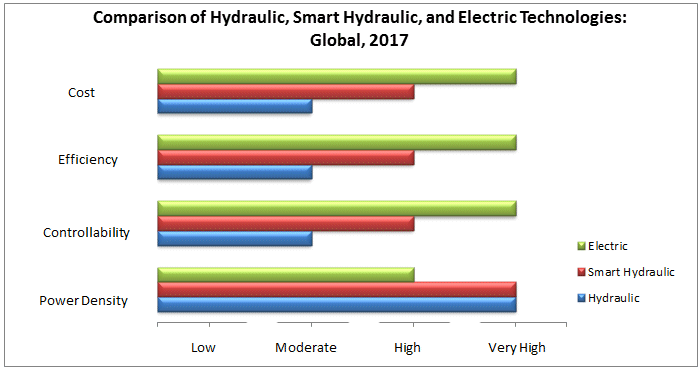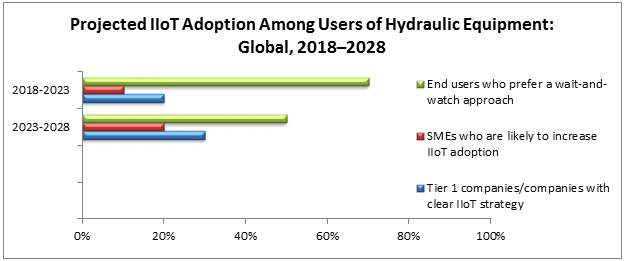In the world of power transmission systems, fluid power systems have remained popular owing to their high-power density and cost advantages compared to electric systems, with hydraulic equipment being the undisputed leader in terms of power density. While a pneumatic cylinder with a 2-inch diameter (3.14 sq. inches area) operating at a pressure of 100 PSI develops 314 pounds of force; a hydraulic cylinder of the same size operating at a pressure of 1000 PSI develops 3,140 pounds of force. In this manner, varying the size of the hydraulic cylinder allows multiplication of force, which enables hydraulic equipment to produce a large amount of force in a compact package.
An electric system would require larger components to produce a similar force output, increasing the cost and complexity of such systems. This principle has enabled hydraulics to remain the power transmission system of choice among manufacturers of construction equipment, agriculture equipment, and other on-highway and off-highway mobile equipment. Similarly, in an industrial environment, machine tools and hydraulic press applications, which are prevalent across multiple manufacturing industries, continue to employ hydraulic solutions for their large power applications.
However, despite these advantages, hydraulic system efficiency and hydraulic fluid leakage concerns persist. This has enabled electric equipment to cannibalize sales of hydraulic equipment, particularly, in North America and Europe, where the hydraulic equipment market is saturated. This trend of migration away from hydraulic solutions toward electric solutions has been visible over the last decade in low-power industrial applications. Hydraulics was once considered irreplaceable in mobile applications due to the power requirements. However, mobile applications are also being electrified, albeit at a much slower pace. Moreover, technical advancements are being made at a faster pace in the field of electrics compared to hydraulics. The pace of innovation in electric solutions combined with the volatile nature of the global economy challenges hydraulic equipment manufacturers to reduce the time-to-market for their smart offerings. The proliferation of the Industrial Internet of Things (IIoT), which is expected to boost the adoption of electric solutions, is also expected to aid the adoption of smart hydraulic equipment.
Smart hydraulic equipment combines the strength of traditional hydraulics with the intelligence of electronics. It enables the collection of operational and process data through sensors embedded within the equipment. This data can be used to not only monitor the performance of the equipment such as pumps, motors, valves, and cylinders, but also predict equipment failure ahead of time. This enables end users to reduce machine downtime, which, depending on the machine and application’s value, could cost end users millions of dollars. Smart hydraulic equipment also requires the use of open-source connectivity protocols to fully utilize its capabilities. While a controller area network (CANBus) is already an established bus network for mobile applications, the increased penetration of Ethernet-based protocols (such as EtherCAT) for both industrial and mobile applications bodes well for the adoption of smart equipment as more end users transition toward smart solutions.

Yet, for all the attention devoted to IIoT, most end users are unsure of how they can currently derive additional value using IIoT concepts in their applications. This is exacerbated by the fact that there is a lack of consensus within the industry about how much end users are willing to pay for smart equipment, making it harder to justify return on investment in smart equipment. As a result, most end users prefer a wait-and-watch approach, looking to identify successful use cases in the industry before they consider upgrading their machinery to smart equipment. However, despite end-user skepticism surrounding IIoT, the need for improved energy efficiency and higher operational efficiency is expected to result in greater adoption of smart equipment over the next 10 years, as smaller and medium sized enterprises (SME) follow the examples of Tier-1 companies. This is expected to sustain demand for hydraulic equipment, as smart hydraulic solutions are less expensive to implement compared to electric solutions.

While emissions regulations are reviewed on a periodic basis, the active dialogue surrounding emissions from the transportation and industrial sector, has given rise to the possibility that the timeframe between future emission revisions would get shorter. More stringent emissions regulations would require manufacturers of on-highway and off-highway machinery to improve the energy efficiency of their products, without sacrificing their power capabilities. While hydraulic equipment offers greater power and lower costs, electric equipment offers greater efficiency and lower maintenance. Additionally, the faster pace of innovation in the field of electrics gives electric equipment more scope to enhance its power capabilities while offering inherent efficiency advantages, thereby posing a greater threat to hydraulics. However, mobile end-users have been using hydraulic equipment for several decades and there is sufficient inertia to migrate to electric solutions. The cost of migration to electric solutions, combined with the unfamiliarity of the technology, reinforces the idea that smart hydraulic solutions are the most viable long-term solutions for increasing efficiency without sacrificing the power capabilities of hydraulics. While industrial applications are less susceptible to inertia, smart hydraulic solutions would be the most practical option for most end users, as it is less expensive to implement compared to fully electric solutions. The anticipated proliferation of smart-leak detection solutions, which can identify the source of an oil leak and raise an alarm, is expected to be a game-changer in the industry. While the trend of electrification is expected to continue, it is imperative that the manufacturing industry takes practical but progressive steps toward a more efficient future. With traditional hydraulics plateauing in terms of efficiency, and electrics aiming to emulate hydraulic power capabilities, smart hydraulics is the ideal middle ground, given the manufacturing industry’s trajectory toward Industry 4.0.



